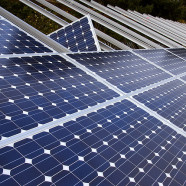Solar LED Lights: The Marriage Of Nature and Technology
By tapping into the sun’s immense energy, “transformative” LED technology is providing clean, efficient lighting for millions of people around the world. Solar LED lights represent not only a dream scenario for the environmentally conscious, but also a chance to provide light in developing countries where access to electrical grids is scarce.
The LED industry has come a long way in the past decade. To illustrate this process, the 2014 Nobel Prize in Physics was awarded to Isamu Akasaki, Hiroshi Amano, and Shuji Nakamura for inventing the blue LED in the early 1990s, which ultimately allowed for the creation of white LED light.
“The LED lamp holds great promise for increasing the quality of life for over 1.5 billion people around the world who lack access to electricity grids,” the Royal Swedish Academy of Sciences noted in their Nobel Prize press release. “Incandescent light bulbs lit the 20th century; the 21st century will be lit by LED lamps.”
One of the great opportunities provided by LEDs is the harmonious relationship they hold with clean, renewable solar energy. Photovoltaic panels create solar energy by converting the sun’s rays into direct current (DC) electricity. This DC current, in contrast to the alternating current (AC) electricity of the conventional grid, is the same form of electricity used by LED lighting. In fact, photovoltaics are also composed of diodes that in many ways are the inverse technology of LEDs.
Most of the time, the electricity collected by solar photovoltaics is not used at the exact moment the sun is shining. This necessitates battery storage to hold this collected energy for later use. Due to their compact size, astounding efficiency, and advanced programability, LEDs are clearly the most effective type of light to draw power from these expensive batteries. During the past decade, the efficiency of LED technology has advanced at 100% per year while prices dropped by 50% per year, which has made it an increasingly attractive option for off-grid solar development.
Solar LED Lights in the Developing World
In India, population 1.2 billion, Prime Minister Narenda Modi plans to put a solar-powered light bulb in every home, bringing light to the entire expanse of the massive South Asian country. In India alone, an estimated 300 million people are not connected to the electrical grid. Instead of building expensive infrastructure through difficult rural terrain, the government plans to use solar energy and LEDs for power and light generation.
In Africa, some 28.5 million people are already using solar-powered LED lights. In times past, the only option for those who lived off the grid was to buy expensive, dangerous, and polluting kerosene lamps or burn wood to have access to light during the night. With solar-powered LEDs, these under-served populations can now charge their lights directly from the sun, affording them access to a clean, renewable and technologically advanced form of home lighting — something that was previously unimaginable.
Solar LED Lights Will Change the Entire World
Many predict the market for solar-powered LEDs will expand far beyond the developing world. The world’s largest investment bank, UBS, released a report arguing that large-scale centralized electricity generation will become obsolete by 2025. The authors expect it will be cheaper for homes and businesses to generate and store their own energy rather than rely on the inflexible conventional electric grid we use today.
Michael Liebreich, founder and CEO of Bloomberg New Energy Finance, agrees: “In most sunny parts of the world it is cheaper to generate power from photovoltaic modules on your roof than to buy it from your utility. The best newly built windfarms are selling power at the equivalent of 3p/kWh before subsidies, which neither gas, nor coal, nor nuclear power can match. LED lightbulbs can be bought for a few pounds, providing homeowners a quick and cheap way of cutting their utility bills. What is even more important is that the cost reductions that have led to this point are set to continue inexorably, far out into the future.”
With so many expert opinions saying the same thing, it sure looks like the sun is shining bright on LED lighting and humanity’s progress into the future.
Questions?
If you have any further questions about LEDs, and specifically LED strip lighting, remotes, and dimmers, please stop by our website at flexfireleds.com or give us a call at 1-844-FLEXFIRE (1-844-353-9347) to talk with one of our design specialists today.











